| Artist and Sculptor Gideon: Biography |
Gideon’s Youth (1924–1942)Gideon was born in 1924 in the small town of Overland Park, Kansas. As a child growing up during The Great Depression and Dust Bowl, life very difficult. His family was struggling to survive and had little time or interest to assist him with what they saw as a passing fancy rather than a talent that should be nurtured. Despite these struggles, his interest in art persevered from an early age. As early as five years old, motivated by his own inner drive, he would fashion paint brushes from twigs, rags and pieces of cotton. He spent hours carving, with only a pocket knife, painting figures with tiny rags on a stick. One of these figures was from the long-running cartoon strip “Bringing Up Father” (a.k.a. Maggie & Jiggs). He entered his carving of Jiggs in a school art contest and won first prize — 25 cents. With his winnings, Gideon was then able to go to the dime store and purchase two very small cans of paint at 10 cents each, the first real paints he had ever had. At the age of 12, he created a remarkable portrait of his grandfather done in blue chalk he had picked up from the hardware store. Many of the items he made, including the 78 year old carving of Jiggs, are still in his possession today.
When he turned 15, Gideon traveled to Inglewood, California. He joined a CCC Camp (Civilian Conservation Corps). These camps were designed to give people something to do and keep them off the streets during The Great Depression. However, it also attracted a lot of undesirables a few of whom, began harassing young Gideon. When he learned about their plan to shave his head and paint it green, he left. Gideon went to stay with his aunt and uncle in Chicago. They lived in a two-story wooden house with two bedrooms and a bath upstairs. His aunt’s mother slept in one of the bedrooms and Gideon had to sleep on a cot at the foot of her bed. While in Chicago, he worked in a machine shop and began training as a welder. He eventually became a certified welder and iron worker for Chicago Bridge & Iron, a skill he would later come to use extensively in his sculptures. While there, he entered the Chicago Academy of Fine Arts where he was enrolled in an evening nude figures charcoal class, the first class you were required to take. Just getting to the school was extremely difficult taking hours of walking in all types of weather. The age-old “When I was a kid, I had to walk miles, to and from school, in knee-deep snow and driving sleet” was a reality for Gideon. Within a few months, someone offered him a job and he left the Academy. The War and Holocaust (1943 — 1946)In 1943, even though as a welder, he had received a military deferment, Gideon went to Kansas City, Missouri, and enlisted in the Army. He remembers the train, with all of the new inductees, pulling into the station outside of Camp Blanding, Florida, and being met by the 66th Division Band. Gideon was placed in Field Artillery. However, shortly after his arrival, he was one of 100 men chosen to undergo Army Ranger training simultaneously with basic training. Upon completion of training and intense testing, he was one of a few in his division who became an Army Ranger. Corporal Gideon was sent to England with the 66th “Black Panther Division” where he awaited orders. His division was scheduled to be a part of the infamous Battle of the Bulge. While crossing the English Channel, their boats were torpedoed resulting in many casualties. Luckily, Gideon was uninjured although he witnessed countless ships in the division exploding and set ablaze. The division, severely under strength, was then re–routed to the front lines in Southern France where Gideon found himself manning a howitzer with the remnants of the 66th. Of his experiences in Southern France, Gideon writes:
Even while engulfed in the war, Gideon continued his passion to draw and sketch, storing his sketches and meager drawing implements in a cardboard canister of the type used to pack howitzer shells. Gideon was reassigned to the 42nd “Rainbow Division” in Salzburg, Austria. At this time, Austria was overwhelmed with homeless civilians, displaced persons liberated from the concentration camps and SS captives. The aftermath of war created a nightmarish logistical problem for the Allies. As an Army Ranger, Gideon was charged with the task of guarding SS captives and tending to displaced persons. Gideon witnessed, first hand, things that have haunted both his dreams and his waking hours through all of the intervening years. He watched the endless trails of lost human beings trundling along the roadsides in an attempt to find their way back home through the ashes and the rubble that were the legacy of World War II. He had seen the fighting of war, perhaps the worst in history, and now he served as an eyewitness to its Genocide and the awful aftermath. Obsessed by the visions he experienced during the war, Gideon would go on to paint and sculpt some of the most harrowing and poignant images of post-Holocaust Europe ever produced. Ironically, at that time, Gideon had never heard of the famous European artists Gauguin, Renoir or Van Gogh and had no idea of the historic implication the time spent in Europe during the war years would have on his future. This can be seen, today, in his Holocaust Collection. In certain circles he is known as the “Holocaust Man.” Consisting of his sketches from the front lines, more than three dozen original paintings and nearly a dozen sculptures (some life-size), Gideon’s Holocaust collection remains an artistic journal to this horrific time in human history. Although this collection is still privately held by Gideon, images of the works can be viewed at http://www.gideonart.com/holocaust or in print or online in the award-winning book, The Holocaust Chronicle on pages 389, 426 and 599. Editor-in-Chief David Hogan wrote of Gideon’s Holocaust works: “The pieces are striking, and have considerable impact on the printed page. I’m very taken by Gideon’s work.” After the War (1946 — present)Commercial & Decorative YearsAfter the war, Gideon settled in Miami, Florida, with “decorations for valor, memories of the kind of combat duty that scars you somewhere inside, and $300.” Shortly after his arrival in Miami, he got married and had two children. With a family to raise, he became involved in commercial enterprises. For a short time, he painted houses on Miami Beach, as well as painted blouses and other decorative items for sale. He briefly attended the Terry Art School in Miami with assistance from the GI Bill, but quickly dedicated most of his waking hours to making a living through his art. Throughout the 1950’s and 60’s, Gideon was contracted by many businesses to provide original works en masse. From an orange juice producer in Lakeland, Florida, to large art prints and reproduction companies and famous hotels, Gideon was in high demand and by some considered the “Top-Selling U.S. Artist.” Although difficult to count in retrospect, it is probable that Gideon produced over 10,000 original works for such entities as the Fontainebleau Hotel (Miami Beach, Florida), Jamaica Inn (Jamaica), Aruba Hotel (Aruba), El Rancho Hotel (Port-au-Prince, Haiti), International Inns (Washington, D.C.), Duck Key Hotel (The Keys, Florida), Rooney Plaza (Miami, Florida), Dunes Motel (Miami, Florida), Americana Hotel (Miami Beach, Florida) , Montmartre Hotel (Miami, Florida), Doral Beach Hotel (Miami, Florida), Key Biscayne Hotel (Miami, Florida), Sands Hotel (Las Vegas, Nevada), Howard Johnson Hotel (Las Vegas, Nevada), Voyager Hotel (Miami, Florida), Ocean Reef Hotel & Country Club (Miami, Florida), Kraft Foods, Burdines Department Store, Richards Department Store, Tip Freeman Pictures, and Turner Pictures. For two years prior to Castro taking control, Gideon kept an apartment in Cuba where he worked during the week. He would fly home on weekends to be with his family as well as to stock–up necessary supplies for the return trip. While at home, he made his own paint and sculpting materials which he then used in Cuba. At that time, there were only two major hotels in Cuba. The Hotel Nacional hired him to furnish, approximately, 1,000 original paintings. The Havana Hilton also hired him to create another 800 - 900 original paintings. During his stay in Cuba, Gideon painted, framed and hung these original pieces in both hotels. Gideon then went south of Cuba to the Isle of Pines, where he produced seven or eight bas–relief sculptures which he, personally, hung on the walls in the auditorium of the El Colony Hotel. To this day, Gideon is unaware of the fate of these works. More than likely, these pieces are lost forever.
A huge success, Gideon was contracted to sculpt more trees for other famous landmarks including Jordan Marsh Department Store, the Constellation Hotel (in Toronto), and Maas Department Store. These projects are all examples of Gideon’s ability to produce, unassisted, quantities of work en masse. It wasn’t uncommon for him to receive single orders for 500 or more original works. For nearly 25 years, this type of commercial decorative art work allowed Gideon to make ends meet and support his family. Discovery & Innovation
Early on, he began a life-long quest to develop a formula for manufacturing large quantities of paint that would not crack or turn yellow with time, and that was also quick drying and pliable. As a child, his daughter Terry recalls “there were always pieces of cardboard covered with globs of paint laying around the house. He would mix color pigment, oil, etc. in five gallon buckets, stirring with a big stick. He did all of this without any knowledge of chemistry.” Gideon could not afford a new drill to make the mixing process easier so he bought a used 3/4–inch drill from a relative for $10. Over the years, when the drill would break he would weld it so it would continue to work. He still has that drill! Without the years of experimentation and eventual development of his own paint, he would never have been able to produce the volume of work that exists today. Gideon firmly believes that the exorbitant cost of art supplies can stifle creativity in people who might, otherwise, pursue a life in art. For nearly 60 years, almost all of Gideon’s original works were created from Gideon’s own paint recipes. Today, these formulas remain close to Gideon and are not available to the public. While creating his paint formulas, Gideon was also developing various sculpting compounds that would not fall apart but would become very solid and hard. The result of this difficult endeavor is a vast collection of sculptures varying in size from small clay studies measuring several inches, to heavy compounds with steel welded frames standing more than seven–feet tall and weighing several thousand pounds. The wide variety of beautiful finishes is indescribable. Like his paints, Gideon’s sculpting compounds are not available to the public and remain valued secrets known only to Gideon. Serious Work & ReclusionWith family life and the commercial art taking most of his time, Gideon still managed to learn, experiment and create what he calls his “serious work.” Immediately after his return from the war, Gideon began painting and sculpting creative, serious art work. He did this both for his own study, as well as to sell to individual art collectors.
Early on, Gideon had dozens of “One Man Shows” and won many awards. Well-known at the time, Gideon did as any other up–and–coming artist. He made waves with these events and personal galleries locally and abroad. However, in the early 1970’s, nearing 50 years of age, Gideon closed the door on public life in the arts. Tired of being worked to the edge with commercialism and decorative art, Gideon decided he was through with art shows and dealers, and sought to focus on his serious works. During an interview by the Clearwater Sun in 1963, Gideon said “At first I painted things the public liked and could pay for... Now I do this sort of thing for myself.” For the next few decades, Gideon created thousands of serious sketches, paintings and sculptures. He operated his own private art gallery in Miami, Florida, selling his works to private collectors directly, as a matter of survival. He never dealt with third–party galleries, auction houses or dealers again. Over the years, Gideon has created one of the largest, most prolific collections of art work by any one man. In modern day, this private collection consists of over 5,000 original works and is still housed and kept by Gideon. Although in recent years, Gideon has begun searching for another entity, such as a private collector or museum or “treasure hunter”, to acquire this collection and share it and his life story with society and generations to come. The Later Years: Gideon in the 21st CenturyUnfortunately, the poor environment Gideon has been forced to work in during the past 60 years has taken its toll on his health. The many chemicals and various epoxies involved in his work, have caused breathing problems. Since the 1990’s, Gideon has suffered from COPD and diminished breathing capacity.
In November of 2002, Gideon left Miami after 56 years and moved to Thomasville, Georgia, in an effort to get away from city life and rest peacefully. At 78 years of age, the relocation of his life’s work was a huge undertaking and one that he doesn’t want to repeat. Gideon’s private art works required nearly a dozen large moving trucks as well as countless trips and man–hours. In 2004, Gideon was diagnosed with a very rare and debilitating disease, Myasthenia Gravis. Plagued with double vision, lack of muscle control, difficulty eating, swallowing and breathing failure, Gideon has truly struggled to continue to paint and sculpt. In February 2009, a tornado ripped through Thomasville, Georgia, touching down very near to the building where most of the artwork is housed. The damage was mostly confined to surrounding trees and the actual building structure. Fortunately, damage to the art was minimal and Gideon was not injured. Even with these hardships, Gideon continued his life’s work.
|
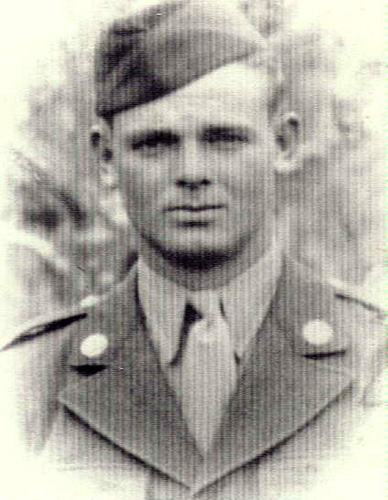
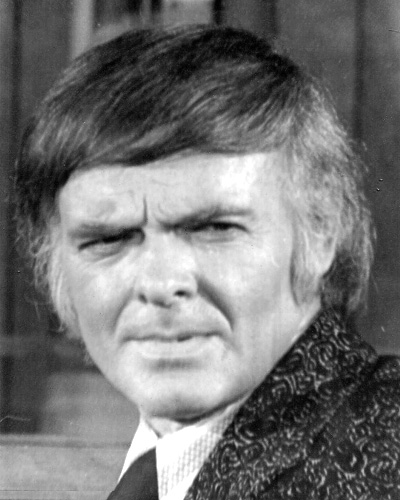
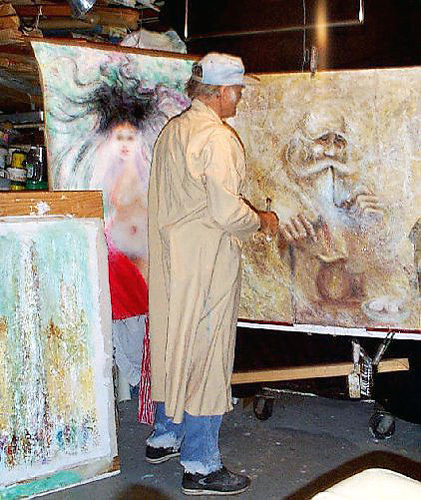

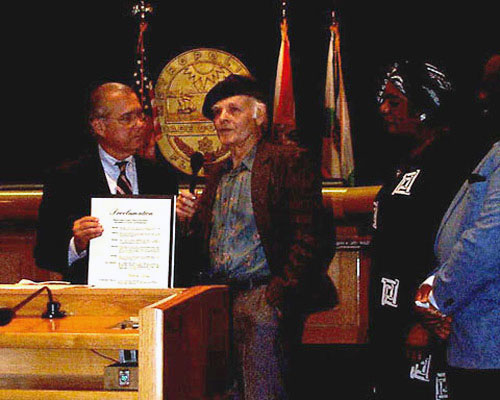

Gideon (born Elmo Gideon) passed away peacefully at his home on Dec. 21, 2010 after a lengthy illness. Gideon is survived by his wife Heather Gideon, sister Eloise Flood, daughter Terry and husband Ed Markham, son Richter and wife Kathy Gideon, granddaughter Jennifer (Markham) Mabe, and grandsons Eric and Adam Markham, and Richter Gideon Jr, and great-granddaughters Ashton and Autumn Mabe, and Bailey and Erika Markham. This site was created to give everyone a chance to participate and show their love and support for Gideon’s family.
Donations may be made online by clicking on the Donate button below, or sent to the Gideon Museum, PO Box 2956, Thomasville, Georgia, 31799.
For more information on Gideon, please visit the artist’s website www.gideonart.com.
 The Artist's Life
The Artist's Life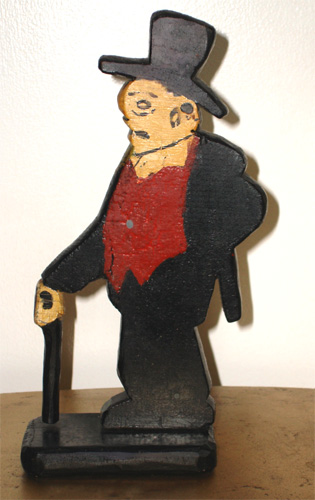 Gideon’s early teenage years were spent traveling from state to state with his father and uncle, both of whom were alcoholic drifters. Working whenever he could find someone who would hire a child, Gideon took on several jobs including working on a farm picking fruit and vegetables, working in a laundry, as a janitor for a church, in a donut shop glazing donuts, in an ice cream manufacturing plant and becoming an experience-trained house painter.
Gideon’s early teenage years were spent traveling from state to state with his father and uncle, both of whom were alcoholic drifters. Working whenever he could find someone who would hire a child, Gideon took on several jobs including working on a farm picking fruit and vegetables, working in a laundry, as a janitor for a church, in a donut shop glazing donuts, in an ice cream manufacturing plant and becoming an experience-trained house painter.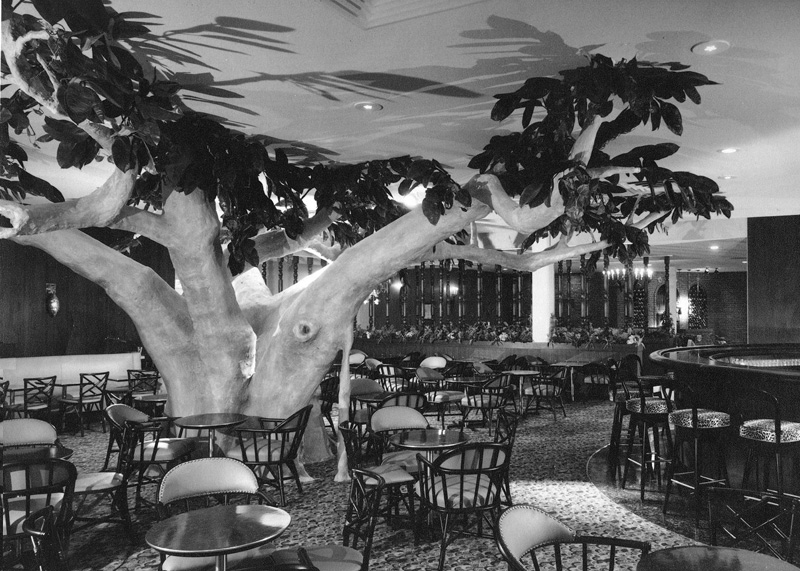 Sculpting, in one form or another, has always been a part of Gideon’s life. In 1957, The Pub, an up-scale restaurant in Coral Gables, Florida, contracted with Gideon to sculpt three trees in the center of the dining room. The 30–inch trunks reached from the floor to a 12–foot ceiling. The limbs from the three trees spanned 30–feet and came together where they were fastened to the ceiling. The sculpting material used to build these beautiful, realistic trees was and continues to be another creative facet of Gideon’s vast repertoire. As a final touch, rufus, long twigs with leaves and sharp ends, were then inserted into the ceiling. These sculpted trees gave the restaurant patrons the unique experience of dining "outside” while, actually, dining inside.
Sculpting, in one form or another, has always been a part of Gideon’s life. In 1957, The Pub, an up-scale restaurant in Coral Gables, Florida, contracted with Gideon to sculpt three trees in the center of the dining room. The 30–inch trunks reached from the floor to a 12–foot ceiling. The limbs from the three trees spanned 30–feet and came together where they were fastened to the ceiling. The sculpting material used to build these beautiful, realistic trees was and continues to be another creative facet of Gideon’s vast repertoire. As a final touch, rufus, long twigs with leaves and sharp ends, were then inserted into the ceiling. These sculpted trees gave the restaurant patrons the unique experience of dining "outside” while, actually, dining inside.